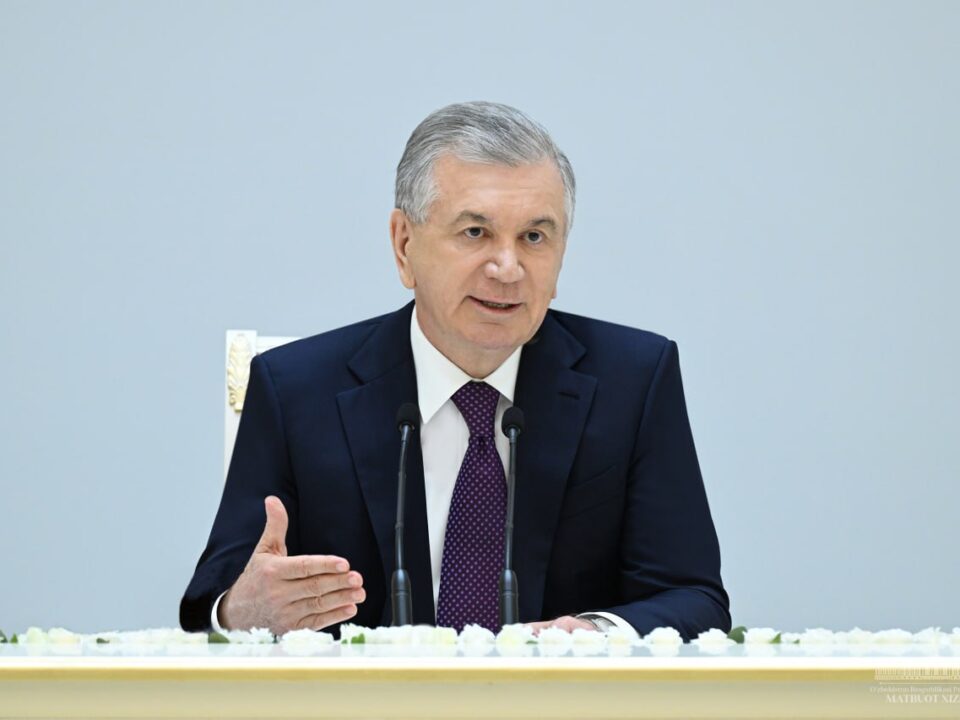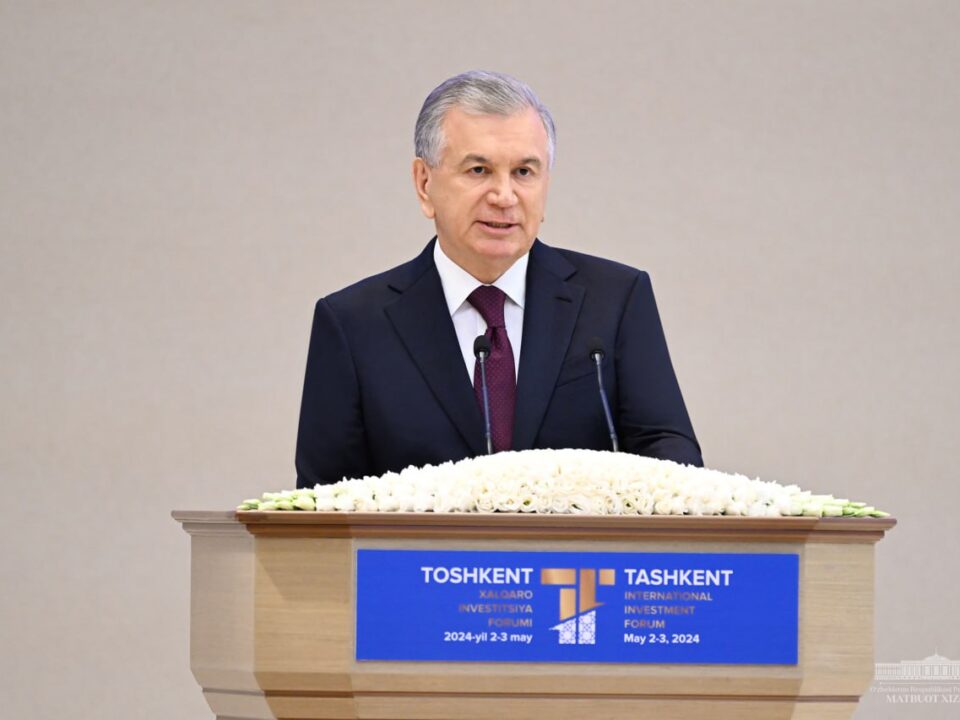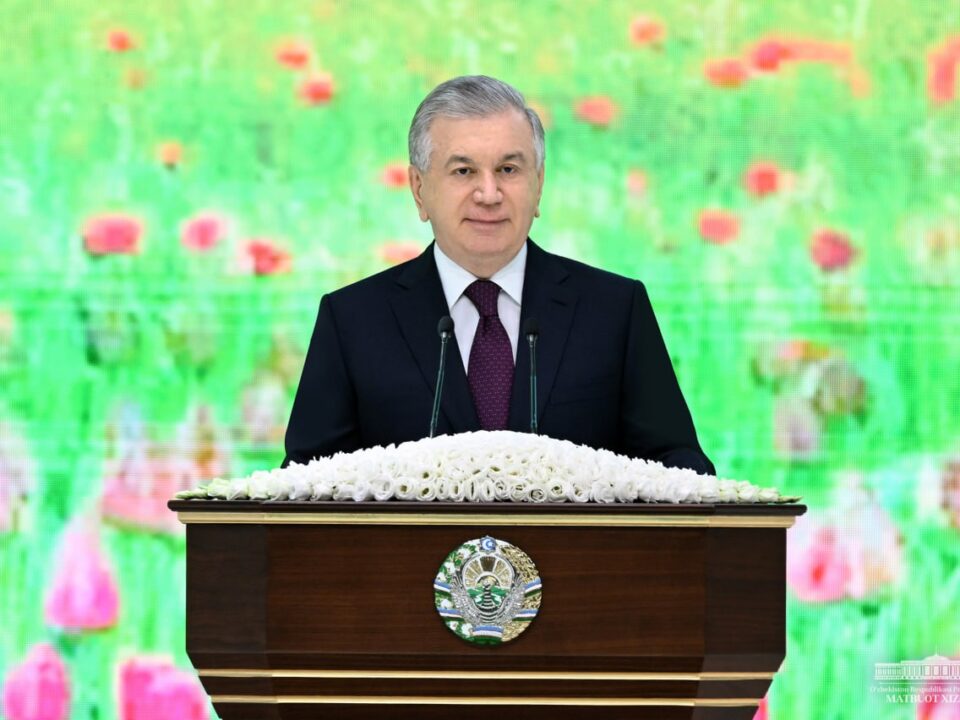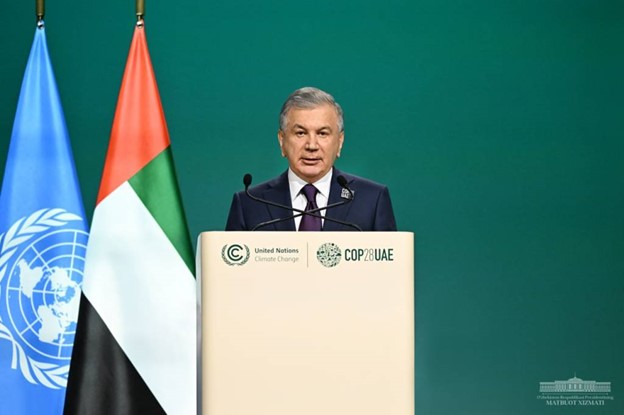Dear Mr. Taleb Rifai!
Distinguished participants of the Forum!
Ladies and Gentlemen!
It gives me an enormous pleasure to welcome You, our esteemed guests, – the leadership and members of the Executive Council, heads of ministries, agencies for development of tourism, scientists and specialists, heads of tourist organizations, representatives of the global tourist industry, and express to all of You my big respect, as well as wish the 99th Session of the Executive Council a productive and successful work.
I would like to express the words of a sincere gratitude to the Secretary-General Mr. Taleb Rifai and all members of the Executive Council for choosing the ancient and eternally young city of Samarkand, which was and remains to be the crossroads of cultures and pearl of the world civilization, as the venue for the Executive Council’s current session.
One can speak a lot about historical significance and beauty of the city of Samarkand.
The city of the almost three thousand-year richest history attracts the attention of travelers, tourists and guests with its majestic monuments of architecture and art of building, its sky-blue cupolas, inimitable oriental image and color.
This wonderful city can charm any person. Once you see it, you shall never forget it.
Recently the respected and internationally acclaimed American Internet edition of Huffington Post has enlisted the city of Samarkand among 50 cities of the world which one must definitely visit even if once in a lifetime.
To me as a man who was born and raised in this city, which naturally combines in itself the ancient epochs and present day, it is of a particular pleasure to see You, all our dear guests, on our hospitable land and say on behalf of all residents of Samarkand and on my own behalf: «Welcome to Samarkand!».
Dear friends!
The main agenda of the today’s session of the Executive Council is the following exclusively substantial topic: «The Great Silk Road – the new prospects of development of international tourism».
Since the ancient times, tourism united the peoples of our planet. People used to set off to travels to discover new lands, learn the world, develop trade and establish cultural and diplomatic ties. The region of Central Asia thanks to its location on the crossroads of caravan trade routes, cultures and civilizations played the most important role in this process.
In the opinion of authoritative scientists, the history of formation of Uzbekistan’s statehood originates from the II millennium B.C. and makes up over 3,5 millennia. Here the centers of formation and development of the ancient statehood are such cities as Samarkand, Bukhara, Khiva and Shakhrisabz – the contemporaries of Rome and Babylon. They are broadly known as the largest centers of medieval science, art and culture, and included to the UNESCO World Heritage List.
Here it will be appropriate to say that for over the last years together with the entire world community we have broadly celebrated the 2750th anniversary of Samarkand, the 2700th anniversary of Shakhrisabz, the 2500th anniversary of Bukhara and the 2500th anniversary of Khiva, as well as the 2200th anniversary of Tashkent.
Yet in the early and late medieval ages, in these cities – the bearers of ancient culture, science and education, the handicrafts and commerce developed, the palaces and temples were built. To construct beautiful cities there were needed not only skilful masters and builders, but also knowledge and experience of scientists who deeply learnt such fundamental sciences as mathematics, astronomy, physics, architecture, geometry, geodesy, seismology and chemistry.
It was particularly those cities and centers of culture through which the Great Silk Road – one of the most significant cultural and socio-economic phenomena of the world history, ran across. Yet in the III-II millennia B.C. the systems of communications were established. They interconnected the most remote cultures and countries in the vast region of the Near East that stretched from the plains of Mesopotamia to the Indus Valley and from the oases of Central Asia to the Arabian Sea. It was those systems of communications that later became one of the major routes of the Great Silk Road.
The expansion of trade relations led to migration of population who carried its customs and worldview which were reflected in the architecture, monuments of culture, numismatics and handicrafts.
The silk was an ideal commodity for trade transportation to far distances which earned the highest profits. Apart from it, many other commodities and goods were traded across the Great Silk Road, including porcelain, mirrors, glasses, carpets, metals, weaponry, various decorations, tea, spices and famous Chinese paper.
Analyzing the history of emergence and formation of international tourism, once again we come to believe that along with establishing the trade relations, leisure and entertainment, such values as learning history, culture, customs and traditions of the nations of the world remained as its equally important components, and as a result, this led to enhancing mutual understanding and strengthening tolerance among people and nations.
All of this was reflected in the dairies of the great travelers and explorers who in different times traveled along the Great Silk Road. There were the people of various nationalities – Chinese Zhang Qian, Italian Marco Polo and Spanish Clavijo, Arabs Ibn Fadlan and Ibn Battuta, American Pumpelly, Englishman Jenkinson and German Schiltberger, Frenchmen Martin and Bonvalot, Hungarian Vámbéry, Swede Hedin and Swiss Maillart. Among them there were people of various occupations – the pilgrims, missionaries, merchants, scientists, diplomats, researchers and writers, but each of them left a tangible trace in the history of emergence and formation of international tourism. And we are infinitely thankful to them.
The visits of foreign ambassadors, merchants and travelers from various parts of the world to Central Asia are reflected in the wall paintings in Samarkand which over 2,5 thousand years ago depicted the scenes of reception at the court of the Afrosiyab ruler of the ambassadors from China, Korea, the states of South and North Asia, and other countries.
Therefore, it is not by chance at all that 20 years ago it was in the city of Samarkand where «The Samarkand Declaration on Silk Road Tourism» was adopted. It declared the objectives of reviving and developing the international tourism along this most ancient transcontinental route that yet 2-2,5 thousand years ago linked by trade and cultural ties the Asian and European countries stretching through vast regions of the Near East, Central Asia and Middle East.
We believe it was an absolutely timely and right decision of the World Tourism Organization adopted in 2004 to establish the Office of the UNWTO «Tourism on the Silk Road» in Samarkand.
Dear participants of the Forum!
Certainly, we do comprehend that the rapidly changing modern situation, acceleration of globalization processes and frequently recurring global economic and financial crises put forward their problems and dictate their terms for development of international tourism.
Taking this opportunity, I would like to briefly dwell on some of them.
The most important factors that define the course of development and efficiency of international tourism, without any doubt, are the problems of ensuring peace and security, political and economic stability in the world as a whole, in the certain regions and each country where tourists are received.
There is no need to prove, and we can see this in the concrete examples, that international terrorism and extremism, growing radicalism, local wars and risks to travel security are those obstacles which nullify any efforts to develop tourism.
Obviously, there is no need to give examples when due to these reasons the tourist flows are sharply decreasing or completely collapsing in the countries where tourism once flourished. All of us do witness this in the example of some countries of the Middle East.
The second problem on which the development of tourism directly depends is the life standards and growing income of population, its well-being.
It is confirmed by the fact that the main growth of global tourist demand starts forming in the rapidly growing economies of the developing countries, and firstly, in Asia. In other words, tourism is a mirror that reflects the level of development of an economy and its state.
Third, today the international tourism is becoming the most widespread and popular type of leisure for a middle class.
It is not difficult to trace such a phenomenon: the bigger and wider the middle class layer in a country, the higher its tourist potential is.
Apparently, there is a factor of the highest mobility of those who attribute themselves to middle class as well as their aspiration to look for something new and desire to realize themselves.
Fourth, it is the level of development of tourist infrastructure, accessibility of tourist sites, convenience of transportation, hotel services and everything related to the tourist logistics, as well as introduction of modern information technologies – everything we come across at every step.
Fifth, much, if not all, depends on the level of investments channeled to the sphere of tourism, including both the budget funds and creation by state of necessary benefits, preferences and incentives for private capital and business to invest in this sphere and development of infrastructure, hotel sector, transport, modern communications and other tourist services.
The activity on construction of tourist complexes, studying and preservation of historical sites, monuments of architecture and art of various epochs and civilizations, as well as development of the tourist logistics depends, firstly, on the aforementioned factors.
Sixth, training and retraining of highly qualified cadres remain as a key and crucial factor to develop the tourist sphere.
Today there are 5 higher education institutions operating in Uzbekistan to train modern specialists, including the Management Development Institute of Singapore in Tashkent and 11 vocational colleges.
Seventh, simplification of visa procedures and other bureaucratic formalities related to tourism, including providing necessary financial guarantees to the activity of tourist firms, play an important role to ensure an accelerated development of international tourism at the modern stage.
In the example of certain countries we see that the absence of such guarantees is becoming a reason for numerous bankruptcies of tour operators and serious obstacle on the way of development and attractiveness of international tourism.
As the international experience shows, along with other factors, tourists appreciate the simplicity and accessibility, opportunity to quickly and affordably complete all necessary formalities to visit countries of their choice.
Introduction of electronic technologies, quickness of obtaining visas, online purchasing of air and train tickets, booking travel tours and hotels on the Internet play a big role in this context.
We can continue this list of the most important conditions and guarantees on which the tourist flows, and finally, the mood of each and every tourist depend. I am convinced that there are no trifles in this business.
Distinguished participants of the Session!
Assessing what was done for over the past period in Uzbekistan, we clearly realize everything that we still need to do to reach the modern world standards in the sphere of international tourism.
I would like to briefly speak about some indicators of development of this sphere in Uzbekistan.
The number of foreign tourists who visited Uzbekistan in 2013 exceeded 2 million people from more than 70 countries. For over the last two years this indicator increased by 43 percent and in the first half of this year more than one million foreign tourists visited our country.
The export of tourist services in 2013 made up over 615 million dollars. Today more than 200 thousand people are employed in the tourist industry and the cumulative share of tourism in the country’s GDP has exceeded 2 percent.
550 tourist companies – tour operators are functioning in Uzbekistan. There are 110 international travel routes which cover most of the historical sites and monuments of architecture. Among them there are 65 sites of historical and cultural heritage, 30 natural and recreational sites, and 15 eco-routes with the elements of health tourism.
Today more than 500 hotels, motels and camping sites with a capacity of over 50 thousand beds are providing services to tourists in line with international standards.
For over the last period the airports of Tashkent, Samarkand, Bukhara, Urgench, Ferghana and Navoi cities were modernized. Today there are 11 international airports operating in Uzbekistan. The national air company operates modern Airbus and Boeing aircraft which carry out regular flights to more than 50 cities of Europe, Asia, Middle East and North America.
A daily high-speed railway service Tashkent-Samarkand-Tashkent by modern electric trains made by Spanish Talgo Company was launched. It is necessary to especially note that with launching the Afrosiyab high-speed train the number of foreign tourists has significantly grown. We have started the projects on electrification and construction of high-speed railway lines to Bukhara and Karshi which will open up the new opportunities for tourism.
During the last five years 2600 kilometers of modern automobile roads were built and reconstructed with a total amount of investments of about 3 billion dollars. The large number of roadside infrastructure, including camping sites, fuel stations, cafés and service facilities, was also built.
This year alone over 580 million dollars of total investments – more than 19 percent growth against the last year – were channeled to develop the main structure of international tourism.
When we speak about the enormous tourist potential of Uzbekistan, firstly, we mean the most ancient civilizations and cultures which emerged and progressed on this territory, rock paintings and hieroglyphs, unique monuments of history, sublime and inimitable samples of tangible culture and architecture which are explored by many scientists and specialists from Japan, France, Germany and other countries, as well as the treasuries and diversity of nature which are not inferior in their beauty to the world’s best destinations of leisure and travel. All of this can and must turn our country into one of the hubs of global tourism. Today there are more than 7 thousand monuments of various epochs and civilizations in Uzbekistan.
I would like to note that we pay a special attention to stimulating the revival and development of national handicrafts which excel in their high aesthetic quality and preservation of traditions of the best artistic masterpieces of antiquity. I would like to emphasize that in our country the sphere of national handicrafts is totally exempted from taxes.
The centuries-old experience of our craftsmen is being yet wider used far beyond our country.
In particular, the medieval decoration of the architectural masterpieces of Uzbekistan serves as a sample in constructing the new religious facilities in the countries of the Middle East and Southeast Asia, and the skills of our ceramics masters are being adopted by specialists of France, Germany, India and other countries.
Uzbekistan annually participates in the largest tourist exhibitions in Paris, London, Berlin, Rome, Tokyo, Madrid and other cities.
The Tashkent International Tourist Fair which will be held this year for the 20th time and expects to host over 12 thousand visitors from more than 40 countries represents today a high-profile venue for a dialogue in the sphere of tourist business.
Dear friends!
We highly value our productive relations and set big hopes to further strengthening cooperation with the World Tourism Organization and implementing the joint programs and projects.
Above all, we speak about significant enhancing the image of Uzbekistan’s tourist potential, raising its attractiveness, firstly, through the Internet, broad-scale promotion of the «Great Silk Road» brand and using the most beautiful and yet unexplored destinations in the Ferghana Valley, ecologically clean foothills in the Tashkent and Jizzakh regions.
We are always happy to see You in Uzbekistan, not only in Samarkand and Tashkent, but in other equally remarkable cities, and let You feel our warm Uzbek hospitality in all of its diversity.
It gives me an enormous joy to express the words of sincere gratitude to everyone present in this hall. I wish You a productive work, sound health, new successes and good luck in your noble endeavors!
Thank you for the attention and respect you show to Uzbekistan.


























